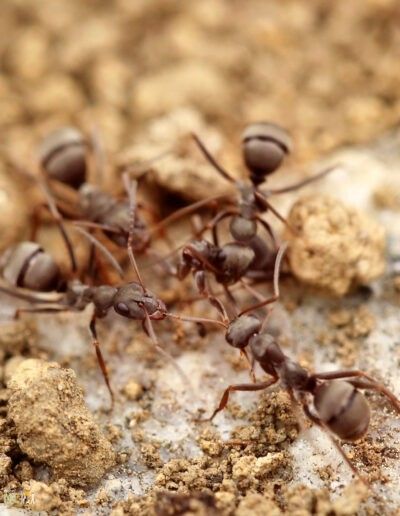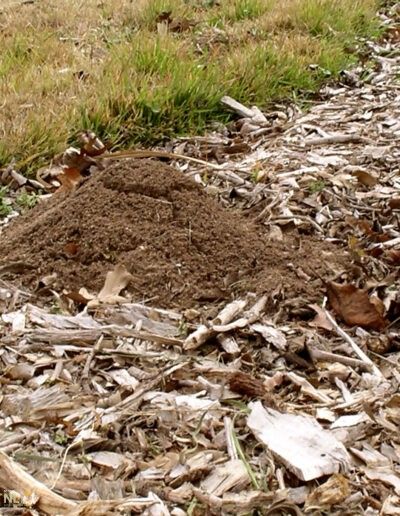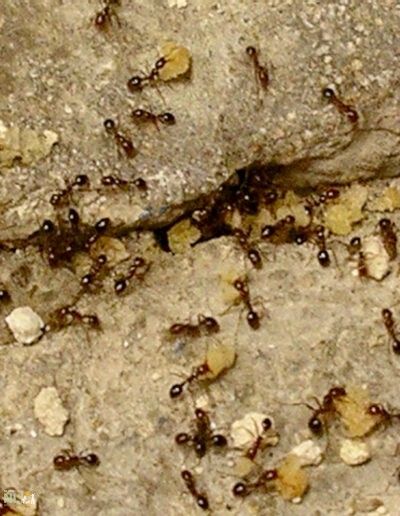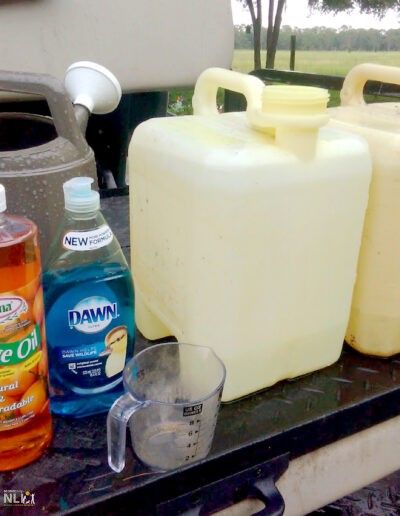31. Fire Ant Prevention and Treatment
Fire ants are a destructive pest that increasingly threaten native species of ants and, as their name implies, can leave painful, itchy “stings.” Although more common in the southeastern United States, fire ants are spreading northward encouraged by climate change. The presence of fire ants in childcare center outdoor spaces can disrupt lawn activities, limit play and learning, and increase anxiety about extended time outdoors. The aim of this InfoSheet is to help identify fire ant mounds; discuss nest and sting prevention, sting reactions; and suggest safe methods for removing fire ants from outdoor play and learning spaces.
IDENTIFYING FIRE ANT INFESTATIONS
Mounds. Fire ant nests are easily identified. They have a distinct dome-shape, with no discernible opening at the top (NCSU Cooperative Extension). From a distance, they look like disturbed earth or small mounds of dirt. Mounds are typically located in open, sunny areas. When disturbed by an unassuming foot or unsuspecting child, fire ants emerge and can repeatedly sting. Identifying mounds and pocking them with a stick to see if they are alive is the simplest way to identify a fire ant infestation.
NEST PREVENTION
Preventing nest establishment in the first place is the most successful prevention strategy. Recommended preventive actions include:
Keeping areas near trash cans clean. Ensure trash is taken out at the end of each day. Outdoor trash cans should be regularly cleaned to remove a potential fire ant food source.
Turn over mulch beds twice a month to discourage nest establishment.
Throw away ripened fruit that has fallen from fruit trees.
STING PREVENTION
To avoid fire ants becoming established and to reduce the risk of getting stung, implement the following preventive measures:
Inspect outdoor spaces regularly between late spring and early fall, when fire ants are most active. If mounds are identified, rope them off or otherwise identify with signs.
Protect feet by wearing socks and closed-toe shoes (children and caregivers) where fire-ant mounds have been identified.
Help children to recognize fire ant mounds and alert them to the risks of getting stung. Ask children to report any fire ant mounds they see to a teacher or caregiver. Make fire ants a learning project!
SYMPTOMS
Symptoms of fire ant stings are severe pain or “burning” sensation at the sting site that lasts 5-10 minutes. A hive- like bump (red spot with raised white center) appears within 30 minutes. Itching follows the pain and can last a week, along with swelling. Redness is common and may last 3 days. Small pimples (pustules) form over the sting within 24 hours. Left alone, they dry up within 4 days. Avoid scratching as they can open and become infected.
For detailed information on sting treatment, including what to do in rare cases of severe reactions, refer to the Seattle Children’s Hospital Fire Ant Sting webpage. If a stung child has trouble breathing, swallowing, or is covered in hives, call a doctor immediately.
NEST REMOVAL: THE HOT WATER METHOD
The hot water method does not use chemicals but can still severely disrupt fire ant activity; however, it requires persistence to treat “satellite mounds” that may appear around the original nest. This method has been reported
to work nearly 60% of the time with repeated applications. Attempt with caution. To reduce risk, avoid carrying hot water over uneven terrain. Recognize that hot water may damage surrounding vegetation and lawn grasses. Treatment steps are described below:
Identify fire ant mound for treatment. Ensure that it is possible to carry near-boiling water from an adjacent building to the mound.
Recruit multiple adults to carry hot vessels to the mound site. Plan the treatment sequence of first heating water, transfer- ring to carrying vessels, and delivering for mound treatment.
Heat 2-3 gallons water to boiling point using available vessels, including tea kettles, which allow for more control of hot water while pouring on mounds. Sufficient hot water may also need to be transferred to milk jugs and/or heavy-duty watering cans for delivery.
Slowly pour hot water on the mounds, being careful to avoid getting scalded. Several applications may be required before lack of ant activity is observed.
NEST REMOVAL: ORGANIC BAIT
Products containing an organic pesticide bait called spinosad are recommended by NC State University Cooperative Extension. The bait is a natural substance made by a soil bacterium that can be toxic to insects.
Usually in granular form, it is sprinkled on fire ant mounds. Select a product containing spinosad that is labeled safe for use on fruit and vegetables. Make sure to follow the instructions on the label, including application steps, health and safety precautions, and exposure avoidance. As organic pesticide products using spinosad may be more difficult to find, check agriculture stores and online sources.
NEST REMOVAL: ORANGE OIL AND DISH SOAP
As an alternative to pesticides, try the treatment studied by Texas Agrilife Cooperative Extension, using 1.5 fluid oz. of orange oil mixed with 3 fluid oz. of Dawn dish soap per mound. Treatment results were significantly better than hot water for decreasing fire ant activity.
For treating multiple mounds, mix ingredients in greater quantities while adhering to the above ratio. See additional listing of potential fire ant treatments by Texas AgriLife (link below).
HEALTH AND SAFETY
- Call a doctor immediately if severe reactions to a fire ant sting occur.
- Inspect outdoor spaces regularly for fire ant mounds to avoid fire ant stings.
- Execute the “hot water” method when no children are present as it can be hazardous. Attempt at your own risk.
- Follow all instructions on product labels closely.
Note: Research on fire ant treatments is still evolving, and methods often have mixed results. If you’ve tried any of the methods listed here and achieved success, or know of other successful treatments, please share your experiences with NLI: nautralearning@ncsu.edu
Resources:
- NC State University Cooperative Extension: Fire Ants in Commercial Turfgrass, Home Lawns and Landscapes. https://www.turffiles.ncsu.edu/insects/fire-ants-in-turf/
- Texas AgriLife Cooperative Extension: Evaluation of organic individual mound drench treatment: Kimberly Schofield, Program Specialist-IPM Professor and Extension Entomologist, Texas AgriLife Extension Service.
- Options for managing fire ants in vegetable gardens (lists several alternatives with ingredients, trade names, and comments. Some may not be suitable for childcare spaces). https://fireant.tamu.edu/
- Oregon State University, National Pesticide Information Center (spinosad data). http://npic.orst.edu/factsheets/spinosadgen.html
- Seattle Children’s Hospital (advice and recommendations from a respected authority on children’s health) https://www.seattlechildrens.org/conditions/a-z/fire-ant-sting/







